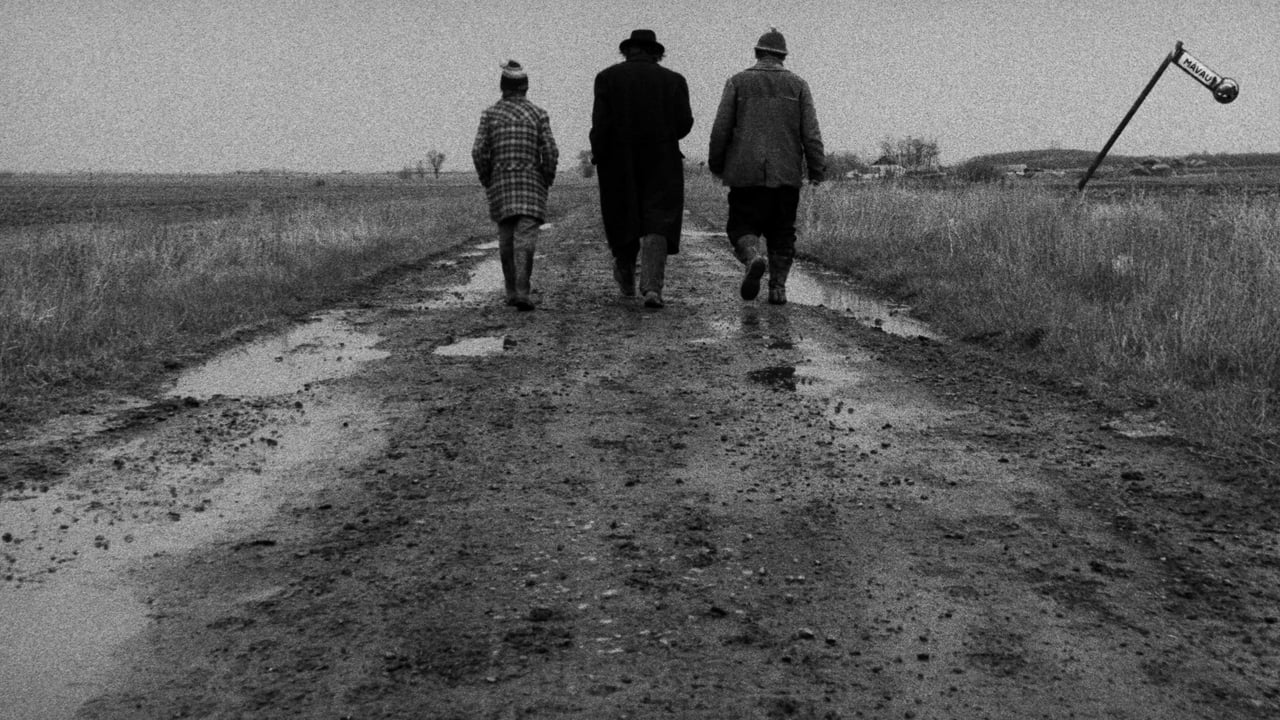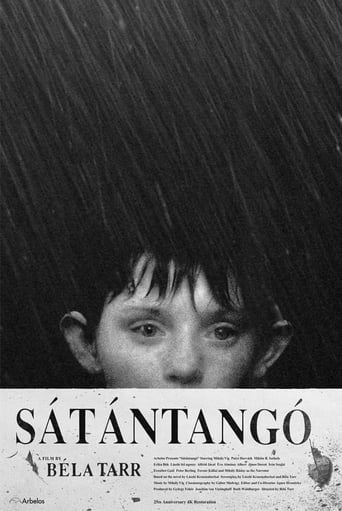

Satan's Tango: You can tell from the first 10 minute enormous tracking shot following cattle meandering in the rain through a devastated, crumbling, seemingly deserted village, that it was going to be THAT kind of film.This is Hungary after the withdrawal of the Soviet occupation of 40 years, and we are at a collective farm on the Hungarian great plain that has collapsed along with Communism.Surreal, mesmerizing, sinister it challenges the mindful viewer to look closely, and listen, rather read closely, except I was lucky to do both. This film is for more mature audiences. I would compare it to plunging into Shakespeare drama that is really hard to follow at first, but pulls you on regardless, even if you are not getting everything, with a big payload.I could not believe I was watching it from when I got home from work till after midnight. One main theme that stuck out for me was how developing a public persona, and the art of speech can be so powerful. The enigmatic central figure, Irimiás, is an epitome of this. Good looking, tall, educated, and with a golden tongue, he sure has a Satanic allure for whom the disparaged, uneducated villagers dance the tango.There are some really funny parts too, the old doc watching and writing everything down in an alcoholic haze, then especially when the two officers rewrite Irimiás' letter and how they describe the villagers. The scene with the little girl and her cat is a heart stopper. I did not get everything to a T and want to read more about this, and want to watch it again.
... View MoreSÁTÁNTAGÓ is a 1992 film by Béla Tarr that takes the Hungarian director's characteristic style to the extreme: this black and white production, based on an eponymous novel by László Krasznahorkai on the dissolution of a Hungarian collective farm in the 1980s, tells its story through a series of long takes, features little dialogue, and runs for over seven hours. While this kind of cinema is certainly not for everyone, if you have watched and enjoyed the longest films by Andrei Tarkovsky (namely ANDREI RUBLEV and STALKER), the director to whom Tarr is most often compared, then this is something for you.I invited some friends over to watch the SÁTÁNTAGÓ on my projector, expecting this to be a trial of endurance where we would give up well before the end. Instead, we were enthralled and watched the whole thing without the slightest complaint. The length of this film is a plus, not a minus, as it places the viewer into a hyper-aware state in which one comes to reflect deeply on the detailed world Tarr depicts. One reason that the film runs as long as it does is that Tarr depicts the same action over 24 hours from different characters' perspectives, so we revisit the events again and again, learning something new each time, and this keeps the suspense up.As the film opens, eight shareholders in a collective farm in rapidly-privatizing Hungary are waiting to get a large payout for the sale of their cattle, and they expect to then go their separate ways. These farmers are deeply flawed (aren't we all?) and intrigues abound. Some of them are already scheming to sneak away with the others' money. Others await the dissolution of their little community with dread: the collective's doctor, obese and alcoholic, is bound to starve without anyone to look after him, and the youngest child feels something evil is in the air. Enter the sinister figure of Irimiás, who had disappeared from the farm long before and was believed dead. He returns with mysterious links to the state, and the last third of the film sets the bickering farmers against the vast country in which they live. While Tarr has denied that he does allegory, his Krasznahorkai source material does seem linked to contemporary Hungary as much as the human experience in general.
... View MoreIf you agree with the following statement, then read on; otherwise skip my entire review.The torturing/killing of living things is NEVER justified if the reason is "for entertainment", or worse, "for art".Good, you're still here which means there's hope for the human race. SATANTANGO features a scene where a real cat is shaken, flipped around, rolled in the dirt, rolled over, shaken again, stuck in a bag and hung on a wall. The torture lasts about 10 minutes and can be seen on Youtube by searching "Satantango cat".Not all countries have animal protection laws, and not all directors respect animal life. Oddly enough, it's often the "enlightened", well-respected filmmakers who are the worst offenders. Watch out for Tarr (Satantango - cat tortured), Tarkovsky (Andrei Rublov - cow lit on fire, horse shot and thrown down stairs), Herzog (Even Dwarfs Started Small - monkey crucified, chickens thrown through window), Von Trier (Manderlay - donkey slaughtered), Coppola (Apocalypse Now - water buffalo partially decapitated), Ki Duk Kim (where to begin?), and the list goes on. You can check all my 1 star reviews for more.To all of the above films I say no thank you, just as I'd prefer not to cheer at a bullfight or adore a Nazi lamp made of human flesh, no matter how "beautiful". I'll stick to directors who show sensitivity and compassion, in front of the lens as well as behind it: Kurosawa, Wenders, Jarmusch, Anno, there are plenty enough films to keep me busy.
... View MoreBela Tarr's seven hour rambling film about the people in a collective in Hungary around the fall of communism.Its good but seeing this in what was a largely single marathon sitting was trying.It's got some wonderful segments and is good over all, but it's a long slog thanks to Tarr's style of long takes and shooting things like the table while action happens off screen. It's a good film and I intend on watching it again down the road, but I don't think I'll be able to sit for the 7 plus hours it took to watch this in one sitting the first time. I'll break it up by sections.Yes I know the length of the film should not come in to play,a good film is a good film, but at the same time this is a slow seven hours.Worth seeing but in bits and pieces
... View More